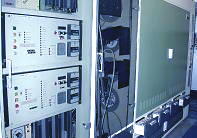Glassivation
Glassivation
is a semiconductor wafer fabrication process that involves the deposition of the
final passivating
layer on
top
of the die to
protect
the die from mechanical damage and corrosion. As the name
implies, this final layer is often composed of an
amorphous
insulating material, or glass.
Silicon
nitride (Si3N4) is a common glassivating
material because of its suitability for this purpose. Highly
resistant to diffusion, it is almost
impenetrable
to moisture and ionic contaminants such as sodium (Na). It can also be
deposited with a low residual compressive stress, making it less prone
to delamination or cracking. Its interfacing with the underlying
metal layers is also very
conformal.
Finally, it can be prepared with very low pinhole density.
Since silicon nitride has a high dielectric constant, it is not popular
as an interlayer dielectric for the simple reason that it results
in a high inter-metal capacitance.
Silicon nitride
can be deposited using plasma-enhanced chemical vapor deposition
(PECVD)
or low-pressure chemical vapor deposition
(LPCVD), although the former
is the technique of choice for glassivation purposes because it allows a
lower processing temperature.
|
 |
|
Figure 1.
Example of an LPCVD system that can be used to
deposit silicon nitride on substrates
|
Wafer Fab
Links:
Incoming
Wafers;
Epitaxy;
Diffusion;
Ion
Implant;
Polysilicon;
Dielectric;
Lithography/Etch;
Thin
Films;
Metallization;
Glassivation;
Probe/Trim
See Also:
Dielectric;
SiO2,
Si3N4
Properties;
IC
Manufacturing; Wafer Fab Equipment
HOME
Copyright
©
2001-2006
www.EESemi.com.
All Rights Reserved.

